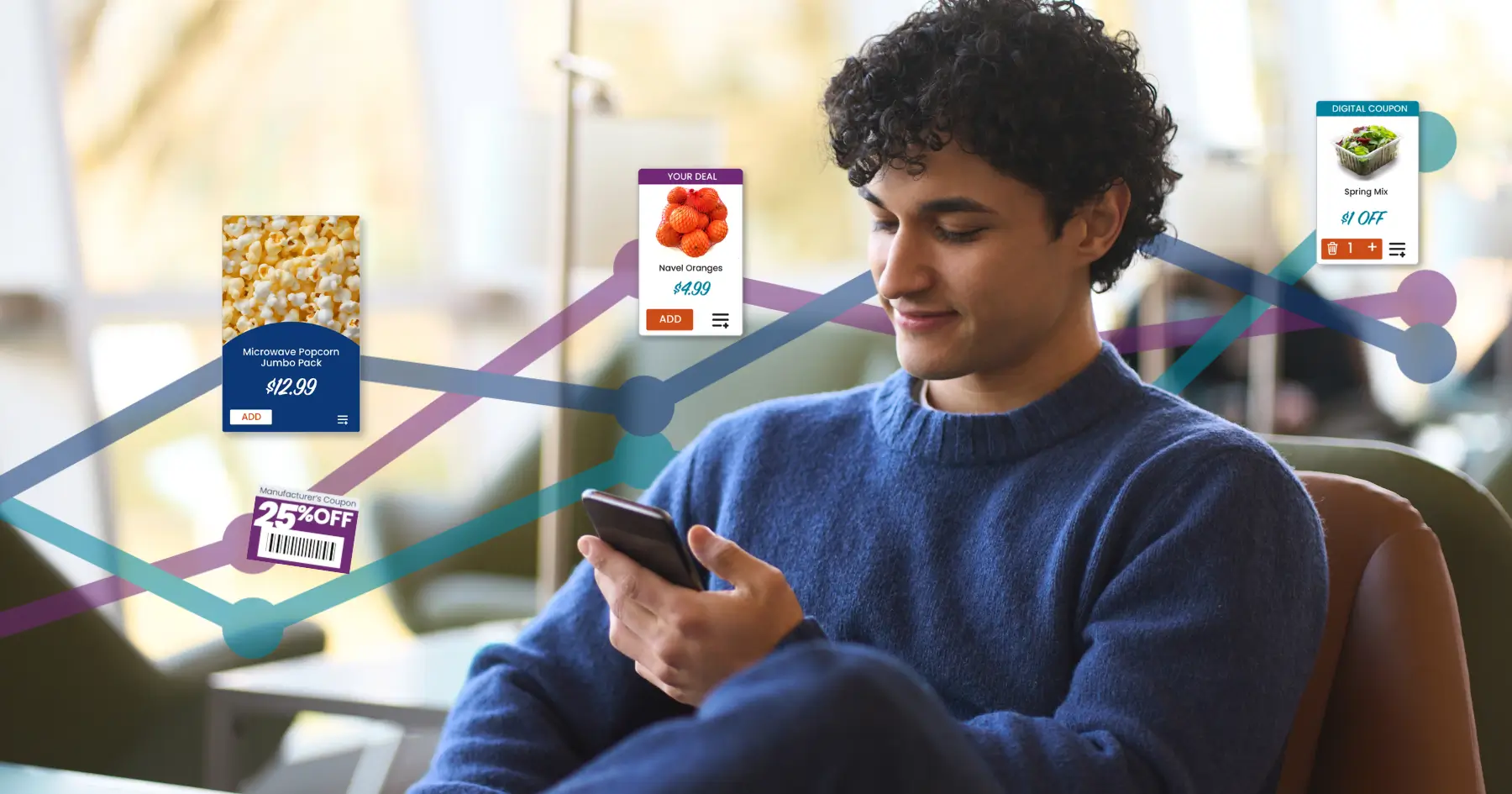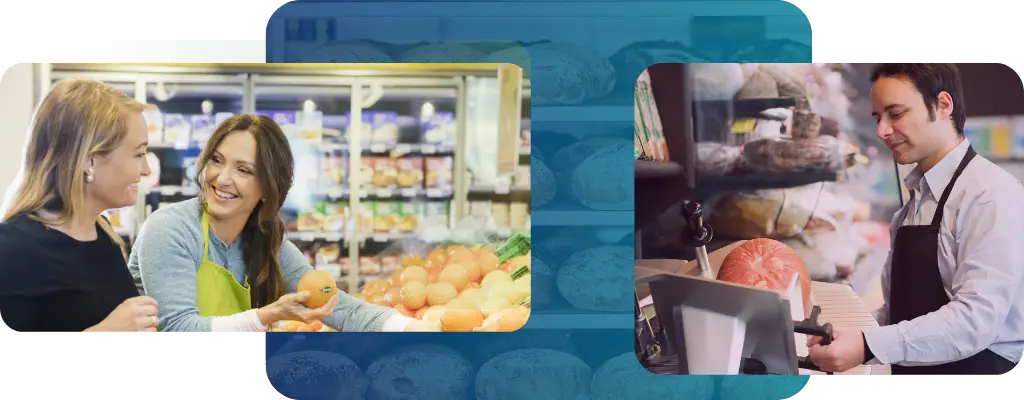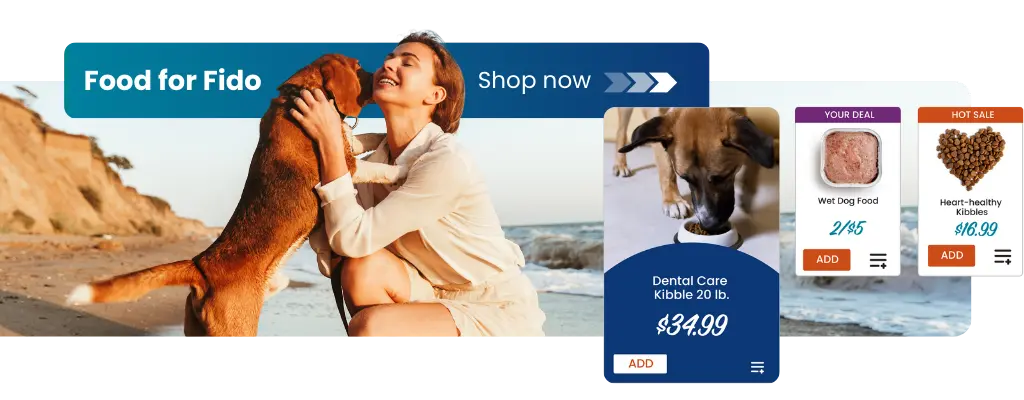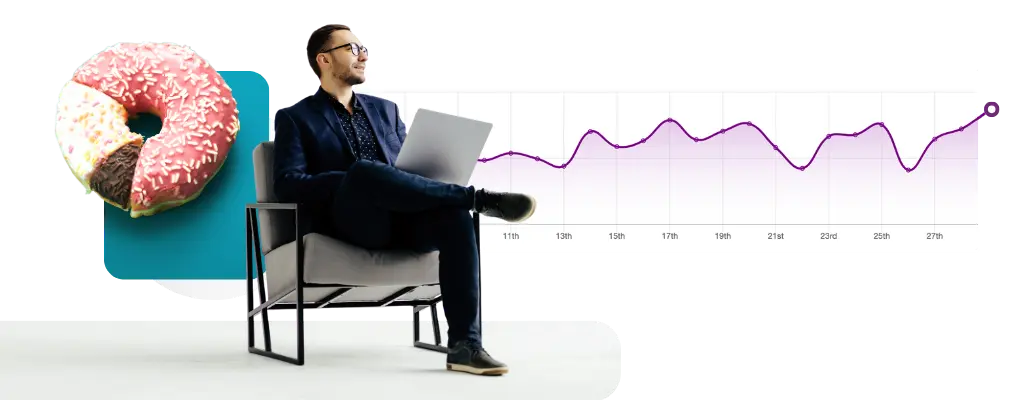
How Retail Media Drives Immediate Revenue and Long-term Growth
This article was originally published on October 20, 2020 with the title “How Digital Grocery Advertising Boosts Your Bottom Line.” It was revised on November 4, 2024.
The concept of breakage is broken.
Unredeemed coupons and offers—once seen as a clever way for grocers to boost profits without sacrificing much—are now outdated in a consumer-focused market where customer retention is more important than ever.
Breakage might have delivered short-term gains by banking on customers not taking full advantage of promotions, but it failed to contribute to the bigger picture: increased customer lifetime value.

In today’s grocery industry, where mass merchants and large retailers are dominating the market, grocers need more than quick ways to boost short-term profits. They need strategies that build strong, sustainable relationships with both their customers and suppliers.
This is what makes retail media such a compelling potential revenue stream for grocery retailers.
Unlike breakage, which serves only the retailer’s short-term interests, retail media generates long-term value by generating immediate revenue for grocers, while also providing consumer packaged goods (CPG) brands with direct access to customers and enhancing their shopping experience .
This win-win-win triple advantage not only boosts profitability but also strengthens the very relationships needed to continue to drive revenue.
In this article, we’ll examine how retail media achieves this—outlining the specific benefits it offers to grocery stores, CPG brands, and customers alike—and why it’s a smarter, more sustainable path forward, especially for regional grocers.
What is Retail Media?
Before we get into the specifics, let’s start with a quick definition and explanation to ensure we’re all on the same page.
Retail media, at its core, is not a new concept. For decades, brands have been advertising their products directly within physical stores, using everything from eye-catching endcap displays to in-aisle promotions. These in-store ads have long been a staple of retail marketing, designed to capture the attention of shoppers and influence purchasing decisions right at the point of sale.
Digital retail media takes this concept and adapts it to the online world.

Instead of in-store displays, digital retail media leverages a retailer’s digital real estate—like their website or mobile app—to place advertisements where shoppers are already engaged in the process of making a purchase. This means that as customers browse products, add items to their carts, or even search for deals, they’re presented with targeted ads from CPG brands that are relevant to their shopping journey.
This method is not only effective but also highly efficient.By reaching consumers at the exact moment they’re making purchasing decisions, retail media generates significant revenue for retailers from sales, yes, but also from brands willing to pay for visibility at that important moment. It also enhances the shopping experience of customers by offering personalized ads and promotions that align with their specific preferences and needs, making their online shopping experience more engaging and relevant.
How Retail Media Benefits Online Grocery Stores
First and foremost, retail media presents a significant opportunity for grocery stores, especially in the face of increased competition from mass merchants and the growing demand for online grocery shopping.
As traditional profit margins are squeezed and the digital marketplace becomes more competitive, retail media offers an alternative revenue stream that can be used to offset costs, and strengthen relationships with both CPG brands and online shoppers.
Here’s how retail media delivers these benefits:
Revenue Generation
Retail media creates an additional revenue stream for grocery stores by allowing them to monetize their digital real estate. This direct access to engaged shoppers is highly valuable to CPG brands.
As we already mentioned, leading brands are willing to pay for premium visibility on a retailer’s website or app, especially at critical moments when more consumers are making purchasing decisions. And when these ads, offers and grocery promotions are personalized to reach a target audience, they’re incredibly effective in driving sales.
That means a dual revenue stream: payment for ad space from brands and increased sales.
And that’s not all. The revenue benefits extend further.
As we’ll explore later in this article, the value and convenience retail media provides to grocery shoppers—through personalized coupons, discounts, and sponsored product samples timed and placed for when desired results are most likely to be achieved—enhances the overall shopping experience. This, in turn, drives customer loyalty and retention.
Ultimately, this translates into higher customer lifetime value. In other words, retail media not only generates immediate revenue and sales but also sets the stage for long-term customer relationships that fuel sustained growth.
Cost Offsetting
Beyond generating revenue, retail media also plays a crucial role in offsetting the costs associated with running and maintaining a robust eCommerce platform.
With US eGrocery sales projected to reach $120 billion annually by the end of 2028, grocers can also expect a rise in operational expenses related to technology infrastructure, logistics, and customer service. Retail media revenue can be strategically reinvested to cover these costs, allowing grocers to improve their digital offerings without eroding their profit margins.
By leveraging retail media in this way, grocery stores can maintain a competitive edge while simultaneously improving the shopping experience.
Enhanced Relationships with CPG Brands
Finally, retail media strengthens relationships between grocery retailers and CPG brands.
By providing a valuable platform for brands to reach their target audiences, grocers can establish themselves as indispensable partners in the marketing and sales process. This collaboration often leads to co-marketing opportunities, exclusive product launches, and better terms in negotiations—all of which further enhance the grocer’s competitive position.
For instance, a grocery retailer that consistently delivers a high return on ad spend (ROAS) through its retail media platform may find that CPG brands are more willing to invest in joint advertising campaigns in the future.
This type of partnership not only boosts sales but also helps the online grocery store differentiate itself in a crowded market.
How Retail Media Benefits CPG Brands
Just as retail media offers significant advantages to grocery retailers, it also provides substantial benefits to CPG brands.
By leveraging the unique capabilities of retail media, CPG businesses can achieve three primary benefits: targeted advertising, valuable data insights, and increased visibility.
Each of these elements plays a crucial role in helping brands connect with customers, optimize their marketing efforts, and ultimately drive sales for their products.
Targeted Advertising
Retail media allows CPG brands to reach consumers at the most opportune moment—right at the point of purchase—with highly targeted ads. By utilizing shopper data provided by retailers, CPG companies can tailor their advertising to specific segments of the audience, ensuring their messages resonate with those most likely to buy.
For instance, a brand launching a new sports drink can use retail media to target ads specifically to shoppers who frequently purchase products associated with fitness, like protein powders and energy bars. This precise targeting increases the likelihood of conversion, ensuring that the brand’s marketing efforts are both efficient and effective.
The result is a higher ROAS as the brand reaches the right customer at the right time.
Data Insights
Another key advantage of retail media for CPG companies is the access it provides to valuable data insights.

Retail media platforms allow brands to analyze shopper behavior and ad performance metrics such as click-through rates and conversion rates. These insights enable the suppliers to refine their marketing strategies and make data-driven decisions that enhance the effectiveness of their campaigns.
If we stick with the sports drink example above, the CPG brand might discover through retail media analytics that its ads perform significantly better on mobile devices compared to desktop.
Armed with this information, the brand can allocate more of its advertising budget specifically to mobile platforms where the athletes are doing more of their online grocery shopping.
This data-driven approach ensures that marketing efforts are continuously refined for maximum impact and optimum spend.
Increased Visibility
Retail media significantly boosts the visibility of CPG brands by placing their products directly in front of consumers during their online grocery shopping experience.
This increased exposure is especially beneficial for new product launches or for promoting specific items that need a visibility boost. By being prominently featured on a grocery retailer’s eCommerce platform, brands can more effectively reach potential customers and encourage product trials.
Again, we come back to the brand introducing its new sports drink. The CPG business could leverage retail media to ensure these drinks are highlighted in key areas of a grocery store’s online platform, such as the homepage or within relevant shopping categories.
This prominent placement helps the brand capture the attention of athletic customers, driving both awareness and trial purchases.
How Retail Media Benefits Grocery Shoppers
The benefits for both grocers and brands is ultimately about providing online grocery shoppers with both value and a streamlined shopping process.
By leveraging the power of personalization, convenience, and product discovery, retail media creates a shopping environment that’s not only more relevant but also more enjoyable and efficient.
Here’s how retail media enriches the grocery shopping experience:
Personalization
The latest technology can be used to deliver personalized advertising to the grocery shopper, where ads are customized based on preferences, shopping history, and behavior.
This level of personalization ensures that customers are presented with products and offers that genuinely interest them and provide real value, making the shopping experience more relevant and engaging.
For instance, shoppers who frequently purchase gluten-free products might be shown ads for new gluten-free brands or special promotions on similar items. This example of a targeted approach would make it easier for each customer to discover products that meet their specific dietary needs, enhancing their overall satisfaction with the shopping experience.
But depending on the software being used, this level of personalization could extend to several hundred different customer segmentations.
Convenience
Retail media seamlessly integrates into the online shopping experience, adding a layer of convenience that’s especially valuable in today’s fast-paced world.
With the ability to add items to their cart directly from an ad, shoppers can make purchasing decisions more quickly and with less effort. This streamlining is crucial as consumers increasingly seek the easiest, most efficient path to completing their purchases.
Imagine a shopper browsing their weekly grocery list and spotting an ad for a buy-one-get-one-free deal on their favorite cereal. With just one click, they can add the promotional item to their cart, making their shopping experience not only faster but also more rewarding.
This ease of use encourages shoppers to take advantage of deals they might otherwise overlook, leading to a more satisfying shopping journey—where they not only find what they’re looking for but also discover new products they didn’t know they wanted.
Product Discovery
That’s the role that retail media plays in helping grocery shoppers discover new products that they might not have considered otherwise.
By showcasing relevant and timely ads during the online grocery shopping process, retail media introduces consumers to a broader range of options, encouraging exploration and—again—enhancing their overall shopping experience.
As an example, a shopper exploring the produce section of an online grocery store might see an ad for a new brand of organic juice. Intrigued, they add the product to their cart, potentially discovering a new favorite that they continue to purchase on subsequent visits.
This element of discovery not only adds excitement to the shopping experience—”What will I discover today?”—but also helps consumers find products that align with their tastes and preferences, making them feel valued with a “made for me” experience.
The Power of Regional Retail Media Networks
We’ve already shown how retail media provides a win-win-win solution for online grocers, CPG brands, and customers.
This scenario—boosting profitability, enhancing relationships, and improving customer experiences—might seem almost too good to be true. It would be disingenuous to suggest implementing a retail media solution doesn’t come with any challenges. However, the most often cited disincentive for regional grocers is based on a misconception.
When discussing retail media, it’s been suggested that regional grocers are too late to capture their share of this market because giants like Walmart and Amazon have already established extensive networks. While competing with these major players might seem daunting, regional grocers actually have a unique opportunity to leverage their own retail media networks.
Rather than going head-to-head with national giants, regional grocers can follow the lead of mass merchants and use their own distinct advantages, particularly in their ability to cultivate close relationships with their customers, to enhance their retail media offerings. This provides advertisers with access to a highly targeted and loyal audience that larger networks may struggle to replicate.
Here’s how regional retail media networks deliver these advantages:
Targeted and Loyal Audience
Regional retailers often possess a deep understanding of their customer base, which allows them to offer advertisers a highly targeted audience. This localized knowledge enables more precise and effective marketing campaigns that resonate deeply with the community, fostering stronger brand loyalty.
Access to First-party Data
One of the significant advantages of regional retailers is their willingness to share customer data with CPG brands. This access to first-party data gives brands a powerful tool for crafting more effective marketing strategies. With precise data, brands can better understand local consumer preferences and tailor their campaigns for maximum impact.
The End Result
Regional retailers can leverage their retail media networks to differentiate themselves from national brands and compete more effectively.
By offering personalized, locally relevant advertising, they can build stronger relationships with both consumers and advertisers, positioning themselves as essential parts of the community.
Why Mercatus is the Tech Partner Grocery Retailers Need
To fully capitalize on these benefits, grocers need a reliable and experienced technology partner.
Mercatus offers a comprehensive suite of solutions designed to optimize retail media strategies and maximize revenue. From data-driven insights to seamless integration across web and mobile platforms, Mercatus empowers grocers to implement effective retail media programs that drive growth and enhance the customer experience.
Mercatus Retail Media also supports real-time performance monitoring, allowing retailers and their advertisers to track key metrics and make data-driven adjustments to campaigns. This level of control and flexibility ensures that grocers can continuously refine their strategies to achieve the best possible outcomes.
Retail media represents a significant opportunity for grocers, CPG brands, and consumers alike. But only by leveraging the right technology and strategic approach, can grocers create a win-win-win scenario that drives revenue, strengthens partnerships, and enhances the online grocery shopping experience.
With Mercatus as their trusted partner, grocers can claim their full share of digital ad revenue.
Book your demo today and take the first step to implementing a powerful new revenue stream for your grocery business.
 Newsroom
Newsroom
